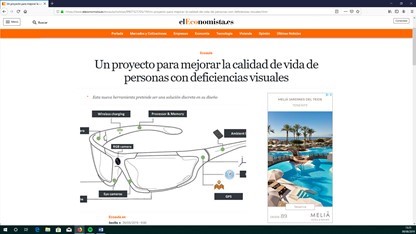A project to improve the quality of life of people with visual impairments
This new tool aims to be an unobtrusive solution in its design

The See Far project, included in the Horizon 2020 framework program of the European Union, aims to provide support to the elder active population with visual impairments. Its development is carried out by a consortium formed by 12 partners from 5 European countries, including universities, technology centers, hospitals and private companies. The University of Seville leads the project, which will be coordinated by Prof. Ramón González Carvajal, full professor of the Department of Electronic Engineering.
See Far aims to be an adaptive, digitally enabled solution that will offer support to the elder active population with vision impairments (a condition directly related to age). Thanks to the development of this tool, these workers can continue to actively participate in professional life, while maintaining and renewing their skills related to work and personal life, with an independent, active and healthy lifestyle.
This new tool aims to be a low-cost unobtrusive solution that will ensure the creation of an intelligent and adaptable work and living environment. To do this, it works with four key elements: physical health, ergonomics / environment, technology and management practices.
The See Far solution will consist of two main components: first, the See Far smart glasses, which adapt to the needs of users and optimize their vision by employing a personalized visual assistant that captures the state of the eye, detects the problem and provides the right fit by integrating augmented reality technologies; and, second, the See Far mobile application, which allows monitoring the evolution of the central vision and the prediction of the risk of disease (for example, diabetes risk, cardiovascular risk). This app will capture images of the retina, through a digital direct ophthalmoscope attached to the smartphone, analyze them and estimate the type and stage of visual impairment, using ‘machine learning’ techniques.
The combination of the output of the See Far mobile application (indicator of the presence or not of a visual problem), with the output of the See Far smart glasses (type of daily visual problems that the user faces and his/her behavior), will lead to the proposal of suggestions and / or assistance to the user, through augmented reality. This will allow the user to maintain an independent, active and healthy lifestyle. Provided suggestions proposals and / or assistance will be adapted to the user’s profile through the personalized visual recommendation service. A combination of advanced technologies in the fields of artificial vision, augmented reality and artificial intelligence will be used to respond to the challenges and objectives of the See Far project.
The project will include the construction of a pre-commercial prototype and its validation (non-medical) through tests with users in a real environment. To this end, it has received funding of 4 million euros from the Horizon 2020 research and innovation program of the European Union.
Original article: https://www.eleconomista.es/ecoaula/noticias/9907527/05/19/Un-proyecto-para-mejorar-la-calidad-de-vida-de-personas-con-deficiencias-visuales.html
Translated by USE

